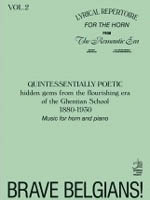Various (Billiet) Brave Belgians, v.2 - Quintessentially Poetic
Horn Solo Collections - Solo w/Piano

-
Various (Billiet)
Brave Belgians, v.2 - Quintessentially Poetic (Billiet)
As described in the preface to Volume 1, players in Belgium developed a particular lyrical and expressive playing style towards the end of the nineteenth century. The highly esteemed horn tradition founded in LiŠge under Hubert Massart (LiŠge, 17931858) and Toussaint Radoux spread to the classes of Brussels and Ghent and mixed with new stylistic currents inspired by the ideas of F.A. Gevaert. Ghent underwent many urban changes between 1890 and 1914, and gained much of its current beauty in those years.The linen industry that had developed strongly in the middle of the century was gradually pushed towards the northern and eastern suburbs, and ambitious urbanization projects created a cosmopolitan "little Paris," with a "historical" city center and flamboyant yet eclectic architectural developments in the newly built districts. The general ambience was one of optimism and brightness, and the city's cultural life flourished in the years leading up the World Fair of 1913, with painters like Th‚o Van Rysselberghe and writers like Maurice Maeterlinck. -
- Category: Horn Solo Collections - Solo w/Piano
- Item: 130044
- Grade/Level:
- Price: $39.95
-
(usually ships in 10 to 15 days)
